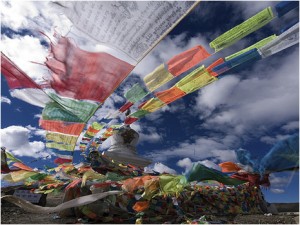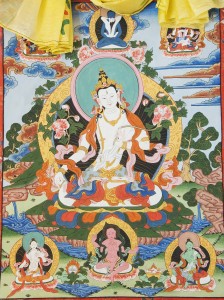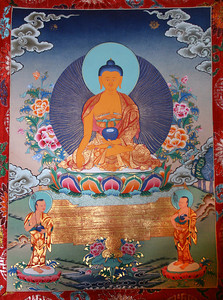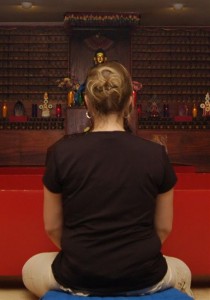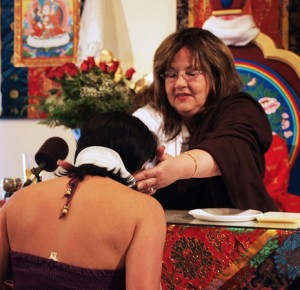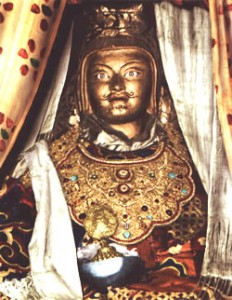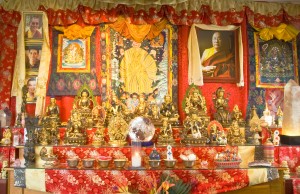The following is an excerpt from a teaching by Jetsunma Ahkon Lhamo called “Your Treasure is Heart”
There are many different ways that one can actually engage and begin to train the mind as a Bodhisattva. Actually, as a Bodhisattva the goal is to make every aspect of one’s life a vehicle for the benefit for others. So, what would that look like? Well, what about the ordinary things that you do? Westerners have all these different elements in their lives, divided into sections, pigeon holes. There’s the holy part, and there’s the ordinary part. There’s your regular personality and the way you are to your husband, wife, kids, in-laws, and all those people that know you better than anybody. There’s another part of your life where you’re out on the street, and people get to see you with your street-face on. And then there’s the personal part. You go to the bathroom and all those kinds of things. There’s the intellectual part, the part that goes to the movies, and the part that exercises. There are all these different parts, and because we’re so deluded, none of them seems to have much relationship to each other. It’s like we’re juggling cats all the time.
One of the things that you have to do as a Bodhisattva is to make your entire life a basket, a vehicle for this compassion. But how do you do that? Well, there are these walking mindfulness meditations that you can do that are extremely beneficial. If you find yourself moving into a depression or some sort of negative mood, if you really try to practice some sort of absorption with them, they’ll pull you right out of it, It’s very simple. You don’t have to sit down and do the “holy” thing. You don’t even have to put on your dharma clothes, pick up your pretty beads, or wear your particular medallions showing that you’re cool. You don’t have to do any of that. All you have to do is, oh, I don’t know, let’s say, eat lunch. As you’re eating lunch, you would pick up a spoonful of the food and you would say a quiet, loving prayer, a heart-felt wish, “As I take this nourishment into my body, may all sentient beings be nourished by the light and power of Bodhichitta. As I take this drink into my body, may all sentient beings be watered and nurtured by the nectar of dharma.” As you walk through the door, “May the suffering of all sentient beings be ended by the virtue of my walking through this door. May they be led through the door of liberation.” It’s a constant mindfulness meditation. As I walk down the street, “May all sentient beings walk down the path to liberation.” In the car while looking at a map trying to find these crazy Washington streets and where they go, “By the virtue of this activity, may all sentient beings receive the proper guidance and direction by which they can accomplish dharma and be free.”
So you have a choice with everything that you engage in. You can be looking at the map and cussing like a trooper, hating the way D.C. is laid out with those weird tunnels, or you can be utilizing the opportunity. You’re going to be looking at the map and finding your street anyway. So instead of getting into a bad mood, perhaps you could use that as an opportunity to understand that all sentient beings are directionless and hungry for direction. A small prayer at that moment that all sentient beings be guided on the path to liberation is appropriate and beneficial. It organizes your mind and thought. Mindfulness becomes so profound and so clarified that almost anything that you’re doing at that time is better, happier. It takes on more meaning. The mind is more clear, less filled with the kinds of hyper-emotions that make us crazy and confused.
Turn everything into that kind of meditation, that kind of consideration for the well-being of others. Everything. “As I ascend the staircase, may all sentient beings ascend into the true meaning of dharma.” You’re free to make up your own prayer concerning the welfare of sentient beings. It doesn’t have to be my prayer. Make up your own. If you constantly walk around like that, you’ll find that you are changing in some subtle way that you can’t understand. You have less bad moods, less depression, less frequent overwhelming concern with your ego to the point where you are busy doing nothing but manipulating everything and everybody around you in order that they will get it right for you, which is pretty much how we live. That kind of thing begins to change and you’re less concerned with manipulating everything and everyone around you in order to get what you want. You spend less time accomplishing the great mantra of “gimme gimme gimme iwant iwant iwant hung phat!” And you are more concerned with the welfare of others. Something inside of you begins to change. Remember, our habitual tendency is so strongly biased toward ego cherishing that we really have to spend a lot of time putting something in the pile of concern for others in order to bring the mind back into some kind of balance. This kind of meditation really brings about that kind of balance, and your habit begins to change.
Copyright © Jetsunma Ahkon Lhamo. All rights reserved

